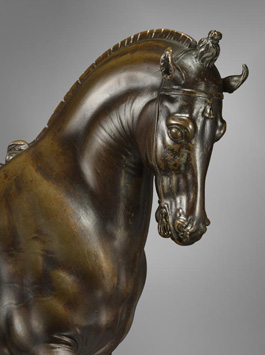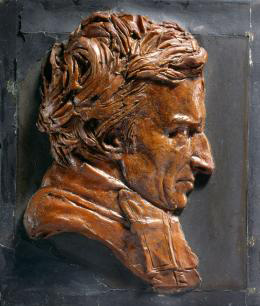The Market for Sculpture
John Haberin New York City
Bronzes from the Hill Collection
Antonio Canova and David d'Angers
Where Mannerism was an art of learning and excess, Neoclassicism began as the art of Revolution. One saw the dissolution of High Renaissance ideals, the other the birth of the French republic and then an empire.
Bronze sculpture from the late Renaissance in the Hill collection and late marble reliefs by Antonio Canova have a way of speaking to one another across centuries, as do smaller metal reliefs by David d'Angers. They can both seem sentimental, extreme, or the intimate expression of their makers. They also shed light on the sentiment and excess of art markets today. 
Backing up
"Sculpture," Barnett Newman quipped, "is what you bump into when you back up to see a painting." Maybe, but sculpture needs attention, too, and thirty-three bronze statuettes at the Frick will do practically anything to get it. Bulls and horses pace, on their way to a sacrifice and to war, while savage lions pounce and roar. Other horses rear in defiance of gravity, while a gilded Christ succumbs to it in death. Struggling warriors play their parts like Olympic athletes, and a Sabine women rising above her rapist, arms out like helicopter blades, earns at least a nine. Scraggly beards and faces speak alternately of fear, pain, and inwardness.
Back up for a proper view of a Tuscan prince on horseback, at more than two feet in height, and one may indeed bump into a painting—one of two by Cy Twombly. Janine and J. Tomilson Hill display their collection much the same way at home, along with paintings by Roy Lichtenstein and Francis Bacon as well. Do Twombly's abstract swirls really echo the drama before them? No matter, for they are still good paintings, and contemporary art at the Frick feels like a peek at forbidden territory all by itself. Earlier art includes an oil sketch by Peter Paul Rubens, from 1620, with its own twists and turns in flight. That gilded Christ finds interesting parallels in early Renaissance Siena, in a painting by Giovanni di Paolo, and in a paint-spattered ceramic from around 1950, by Lucio Fontana.
Back up a minute, though. Does the show offer guilty pleasures, justly unfamiliar artists, and obscure subjects from myth? So from the very first did small bronzes on their pedestals. Where painting and sculpture in churches, public plazas, and now museums still define the public face of art, another form was entering homes and palaces, starting as early as 1460. A new class of connoisseurs and private collectors would delight in the feats of Hercules, a reclining Venus sliding off her couch, the god of war and the goddess of the hunt in stately repose, or the muse of astronomy. They would take pride in knowing that an ancient Greek bore a strigil, an instrument to scrape away sweat and oil—or that a wrestler named Milo of Croton tested his strength against a great oak only to find himself caught in its branches and about to die.
The Frick shows the evolution in brief of that new class and the medium. The strigil bearer from the early 1500s displays a firm stride and High Renaissance dignity, in the hands of Andrea Riccio. The virtuosity and torment of the Sabine woman exemplify the late Renaissance, thanks to Antonio Susini, while the gilded Christ, the pacing horse, and astronomy are all from his influential teacher, Giambologna, who died in 1608. Mars, by Willem van Tetrode, and another dead Christ with heavy eyelids and a waistcloth blown outward in the wind, by Allessandro Algardi, carry the tale to the more naturalistic motion of the Baroque. Are the prince on horseback, a smiling Hercules, and their assumed dignity even more over the top but without the emotion? Giuseppe Piamontini was working in the early eighteenth century, an age of empire.
Still, the show's heart belongs to the 1500s, and so do the self-conscious learning and exaggeration. The curator, Denise Allen, styles these as Renaissance and Baroque bronzes, but one might better describe them as the emergence and afterlife of Mannerism. That has an interest, too, while also accounting for the obscurity, including other artists best left to specialists. It has a particular interest today, for art wrestling with both new wealth and a wider audience. In another painting, with text over a cloudy sky from 1988, Ed Ruscha adds his own jaundiced view of the Baroque—as a time of Alchemy! War! Taxes! Plague! Damsels! Melancholia! Firewood! Substitute hedge funds for alchemy and fossil fuels for firewood, and one might feel at home today.
The show is contemporary, too, in asking about the distinction between art and design, when both are collectibles. On the one hand, bronzes and private collections took shape along with the very idea of fine art. On the other hand, they fell between utilitarian needs and the art that has mostly entered art history. The Frick has always had bronzes in its rooms for paintings, including Riccio and Giambologna, in deference to Henry Clay Frick himself. This show differs only in that one cannot ignore it or back into it. Besides, amid the voices decrying contemporary art as Neo-Mannerism, one may as well enjoy the real thing.
The tomb of Neoclassicism
When Antonio Canova conceived his last work, after Canova's Washington, he had more on his mind than the death of a movement. The Met gets to call its display in the Lehman wing, curated by Peter Jonathan Bell and Paola d'Agostino, "The Seven Last Works"—but only because he did not live to complete thirty-two panels, for a temple frieze in Possagno, his hometown in the Republic of Venice and the site of his remains. He had designed a mausoleum not long before for Titian in Venice (which also holds Canova's heart), and prophecies were on his mind. The 1822 reliefs, the museum notes, include two creations, two sacrifices, and two revelations, pairing Old Testament and New. As the most acclaimed sculptor of his day, he could also safely leave the carving in marble to others. Still, his full-scale plaster shows not just the work of his hands, but the fate of Neoclassicism as well.
The Renaissance long before had been a rebirth of classicism, starting with its name. Painting sought models for its renewal in both antiquity and contemporary sculpture, like the reliefs on Florence's Baptistery doors by Lorenzo Ghiberti. Yet sculpture in the late eighteenth and early nineteenth centuries typically trails, with good reason. Jacques-Louis David in French Neoclassicism found inspiration instead in theater, and later J. A. D. Ingres elevated painting—especially the painting of Raphael. They were creating a drama of human virtue, engaging the viewer as audience, and their greatest tool was not volume but line. And so it was for Canova.
 No wonder he chose relief. The white marble empties the scene of color, and the actors proceed as on an empty stage. Canova places all but God in strict profile against a flat surface, with no hint of a background in nature or architecture beyond the steps of an altar or temple. They reach toward one another, like Mary and Elizabeth at the Visitation or the infant Jesus and Simeon in the presentation in the Temple. At the sacrifice of Isaac or with Cain and Abel, only one of two reaches up, and it is in vain. In each case, the pairs form a duly monumental triangle connected by a sweeping curve.
No wonder he chose relief. The white marble empties the scene of color, and the actors proceed as on an empty stage. Canova places all but God in strict profile against a flat surface, with no hint of a background in nature or architecture beyond the steps of an altar or temple. They reach toward one another, like Mary and Elizabeth at the Visitation or the infant Jesus and Simeon in the presentation in the Temple. At the sacrifice of Isaac or with Cain and Abel, only one of two reaches up, and it is in vain. In each case, the pairs form a duly monumental triangle connected by a sweeping curve.
The curve takes over more fully for the creation of Adam and the creation of the world. God rolls in on the arcs of his robe and clouds. Maybe Canova, born in 1757, remembered how he himself had taken Rome early on by storm. The sculptor treats clouds as a series of overlapping disks, as if the sun and moon above had swept in with him. God's entrance comes as a vision, almost as for William Blake. And that opens the question of how quickly Neoclassicism was on its way out and Romanticism on its way in.
In Walter Friedlaender's 1952 history, From David to Delacroix, Romanticism was lurking almost from the start. Friedlaender notes "an emphasis on sentiment and emotion" and "a taste for the ghastly, even for the cruel." For Canova, the ghastly appears in the sacrifice and Cain's satanic ugliness, but the sentiment is everywhere—in the closed eyes, vapid faces, limp bodies, curly hair, and false solemnity. Not even Adam created in the image of God has much in the way of anatomy, beyond an indent for the muscles of his seat, although he plants both feet flat to the ground. At the Annunciation, Mary bows her head while the angel brings stillness and a lily rather than action or illumination from heaven. Her purity matters even more than the revelation.
As it happens, the Frick took a step closer to Romanticism this past fall, with David d'Angers. The curator, Emerson Bowyer, even called the show "Making the Modern Monument," but artists looking for burial need not apply. His drawing of a woman in profile has the fine line and fine shading of Ingres, but his work has a still greater ambivalence about the transition to the future. d'Angers needs both the classicism and the suffering of a columnar neck and bent head, as La Douleur (pain or sorrow). A warrior has feet planted firmly on the ground, like Adam at the creation, but an implausible sway into depth and toward the action, in one more gentle curve. Even the Apollo Belvedere lies on its back asleep.
As for the ghastly, a noble woman stands before a scaffold to commemorate a massacre. Men run to hooked noses, as if the only way to mark them with a soul. For his format of choice, d'Angers leaned to portraits in relief, the bronze profile medallions insisting on classical virtue and inner genius. His subjects, too, document the emergence of Romanticism. They include Alexandre Dumas, Victor Hugo, and in the arts Eugène Delacroix, Delacroix drawings, and Théodore Géricault. Their brooding is more concretely a part of this world than Canova's whiteness, but literature and painting still come first.

"Renaissance and Baroque Bronzes from the Hill Collection" ran at The Frick Collection through June 15, 2014, "Antonio Canova: The Seven Last Works" at The Metropolitan Museum of Art through April 27. "David d'Angers: Making the Modern Monument" ran at the Frick through December 8, 2013. A related review looks at Canova's Washington.




